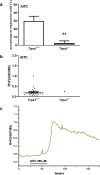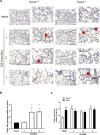The TRPA1 cation channel is upregulated by cigarette smoke in mouse and human macrophages modulating lung inflammation
- PMID: 40148437
- PMCID: PMC11950515
- DOI: 10.1038/s41598-025-95662-y
The TRPA1 cation channel is upregulated by cigarette smoke in mouse and human macrophages modulating lung inflammation
Abstract
Cigarette smoke (CS) is a well-known source of several inflammatory, cytotoxic and genotoxic compounds that cause chronic lung diseases. The transient receptor potential ankyrin 1 (TRPA1), a smoking-responsive, non-selective cation channel, is expressed by both capsaicin-sensitive peptidergic sensory nerves and non-neuronal cells of the lung, but there are few and controversial data on its expression and function on macrophages. Here, we investigated TRPA1 mRNA and protein expression in mouse and human lung tissues and human 3D spheroids, with a particular focus on its expression and potential regulatory effects on pro- and anti-inflammatory macrophage functions in response to CS. TRPA1 was stably expressed in both human and mouse alveolar macrophages, being upregulated after CS exposure and its functional activity was demonstrated in mouse macrophage culture. Moreover, besides CS, the TRPA1 genotype itself affected the expression of M1- (Il-1β, Il-23) and M2-type (Il-10, Tgfβ) macrophage cytokines. Furthermore, CS extract increased TRPA1 mRNA in human lung spheroids showing more prominent expression in macrophage-containing 3D aggregates, while CS extract influenced an elevated TGFβ expression specifically in macrophage-containing spheroids. These results suggest the fine-tuning role of TRPA1 activation in CS-induced airway inflammation, particularly in macrophages, but further studies are needed to draw precise conclusions.
Keywords: 3D human lung spheroid; Airway inflammation; Alveolar macrophage; Cigarette smoke exposure; TGFβ; TRPA1.
© 2025. The Author(s).
Conflict of interest statement
Declarations. Competing interests: The authors declare no competing interests.
Figures





References
-
- Kataoka, Y. et al. TRPA1 Channel Activation With Cinnamaldehyde Induces Cutaneous Vasodilation Through NOS, but Not COX and KCa Channel, Mechanisms in Humans. www.jcvp.org (2022). - PubMed
-
- Lindsay, C. D. & Timperley, C. M. TRPA1 and issues relating to animal model selection for extrapolating toxicity data to humans. Hum. Exp. Toxicol.39, 14–36. 10.1177/0960327119877460 (2020). - PubMed
-
- Trevisani, M. et al. 4-Hydroxynonenal, an Endogenous Aldehyde, Causes Pain and Neurogenic Inflammation Through Activation of the Irritant Receptor TRPA1. www.pnas.org/cgi/content/full/ (2007). - PMC - PubMed
MeSH terms
Substances
LinkOut - more resources
Full Text Sources
Medical

